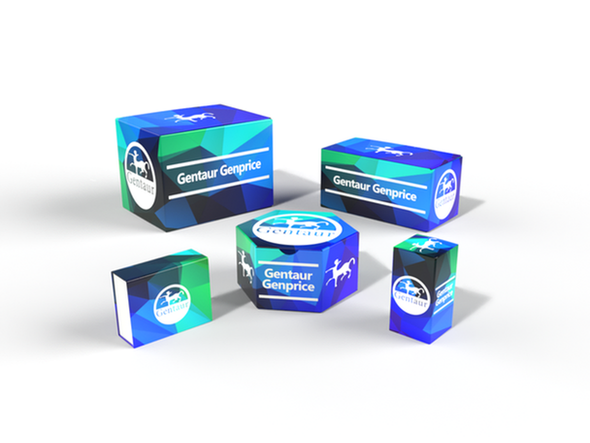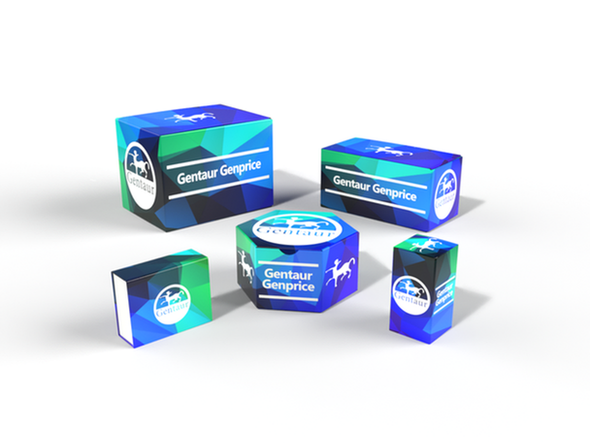749
Rat Lamin A/C (LMNA) ELISA Kit | KTE100696
- SKU:
- 749-KTE100696
- Availability:
- Usually ships in 5 working days
Description
Rat Lamin A/C (LMNA) ELISA Kit | KTE100696 | Gentaur UK, US & Europe Distribution
Application: This Rat Lamin A/C (LMNA) ELISA Kit employs a two-site sandwich ELISA to quantitate LMNA in samples. An antibody specific for LMNA has been pre-coated onto a microplate. Standards and samples are pipetted into the wells and anyLMNA present is bound by the immobilized antibody. After removing any unbound substances, a biotin-conjugated antibody specific for LMNA is added to the wells. After washing, Streptavidin conjugated Horseradish Peroxidase (HRP) is added to the wells. Following a wash to remove any unbound avidin-enzyme reagent, a substrate solution is added to the wells and color develops in proportion to the amount of LMNA bound in the initial step. The color development is stopped and the intensity of the color is measured.
Detection Method: Colorimetric
Conjugate: N/A
Sample Type: Cell culture supernatants#Serum#Plasma#Other biological fluids
Assay Type: Multiple steps standard sandwich ELISA assay with a working time of 3-5 hours. It depends on the experience of the operation person.
Kit Component: • Rat Lamin A/C microplate
• Rat Lamin A/C standard
• Rat Lamin A/C detect antibody
• Streptavidin-HRP
• Standard diluent
• Assay buffer
• HRP substrate
• Stop solution
• Wash buffer
• Plate covers
Features & Benefits: Rat Lamin A/C (LMNA) ELISA Kit has high sensitivity and excellent specificity for detection of Rat LMNA. No significant cross-reactivity or interference between Rat LMNA and analogues was observed.
Calibration Range: Please inquire
Limit Of Detection: Please inquire
Usage Note: • Do not mix components from different kit lots or use reagents beyond the kit expiration date.
• Allow all reagents to warm to room temperature for at least 30 minutes before opening.
• Pre-rinse the pipet tip with reagent, use fresh pipet tips for each sample, standard and reagent to avoid contamination.
• Unused wells must be kept desiccated at 4 °C in the sealed bag provided.
• Mix Thoroughly is very important for the result. It is recommended using low frequency oscillator or slight hand shaking every 10 minutes.
• It is recommended that all samples and standards be assayed in duplicate or triplicate.
Storage Instruction: The unopened kit should be stored at 2 - 8°C. After opening, please store refer to protocols.
Shipping: Gel pack with blue ice.
Precaution The product listed herein is for research use only and is not intended for use in human or clinical diagnosis. Suggested applications of our products are not recommendations to use our products in violation of any patent or as a license. We cannot be responsible for patent infringements or other violations that may occur with the use of this product.
Background: The nuclear lamina consists of a two-dimensional matrix of proteins located next to the inner nuclear membrane. The lamin family of proteins make up the matrix and are highly conserved in evolution. Lamin A is targeted to the nuclear membrane by an isoprenyl group but it is cleaved shortly after arriving at the membrane. It stays associated with the membrane through protein-protein interactions of itself and other membrane associated proteins, such as LAP1. Depolymerization of the nuclear lamins leads to disintegration of the nuclear envelope. Transfection experiments demonstrate that phosphorylation of human lamin A is required for lamin depolymerization, and thus for disassembly of the nuclear envelope, which normally occurs early in mitosis.
Alternative Names: LMNA; RP11-54H19.1; CDCD1; CDDC; CMD1A; CMT2B1; EMD2; FPL; FPLD; HGPS; IDC; LDP1; LFP; LGMD1B; LMN1; LMNC; PRO1; 70 kDa lamin; OTTHUMP00000015843
Search name: LMNA; RP11-54H19.1; CDCD1; CDDC; CMD1A; CMT2B1; EMD2; FPL; FPLD; HGPS; IDC; LDP1; LFP; LGMD1B; LMN1; LMNC; PRO1; 70 kDa lamin; OTTHUMP00000015843
Tag: LMNA






